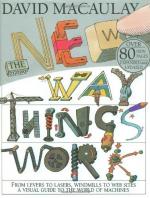
|
| Name: _________________________ | Period: ___________________ |
This test consists of 5 short answer questions, 10 short essay questions, and 1 (of 3) essay topics.
Short Answer Questions
1. What are magnetism, heat, and light in relation to an electron's movement?
2. To what is the mammoth's presence reduced?
3. What colors make up all light?
4. How are positive and negative electrons similar to positive and negative poles?
5. Why do electromagnets use the forces of attraction and repulsion alternately to keep machines running?
Short Essay Questions
1. Discuss the three principles which govern the flow of electricity.
2. How is magnetism caused?
3. What makes it possible to use waves to communicate? How is this done?
4. What is the input?
5. What are analog quantities and how are its levels described?
6. Discuss sound waves.
7. How is static electricity formed?
8. Who is the last mammoth?
9. How does Bill record the binary numbers of the mammoth's physical presence?
10. What are bar codes?
Essay Topics
Write an essay for ONE of the following topics:
Essay Topic 1
Discuss the following:
1) Define the term vacuum.
2) How does a thermos use the principle of a vacuum to keep things hot or cold? Why does a thermos ultimately lose its heat or cold?
3) What is combustion and how is it explained at the molecular level?
4) How do combustion machines take advantage of the principle of combustion?
5) Explain how explosives work and what components must be present in an explosive.
Essay Topic 2
Discuss the following:
1) How does Macaulay use the term wheel and axle?
2) How is the wheel and axle related to a screwdriver? To the Hand Drill? A wrench?
3) Do you think the wheel and axle discussed in The New Way Things Work is an important invention? Why or why not.
4) Research the history of the screwdriver. When was it invented? By whom? Where? How were the first screwdrivers made? How are they made today?
Essay Topic 3
Discuss the following:
1) Why is a screw an inclined plane? Explain the basic design of a screw. How does it work as a wedge? What is the value of understanding the principle upon which a screw works?
2) What is an auger? How does an auger work according to the principle of a wedge?
3) Upon what principle of physics is a drill designed? What is another tool that works upon the same principle? How are the two tools alike? How are they different?
|
This section contains 743 words (approx. 3 pages at 300 words per page) |

|




